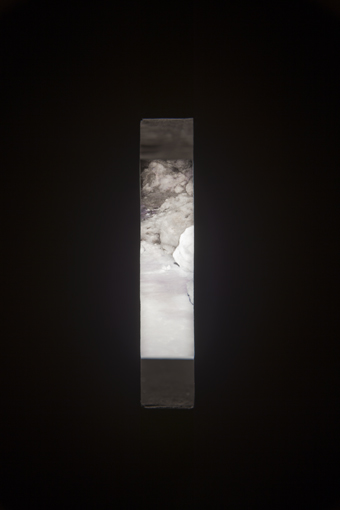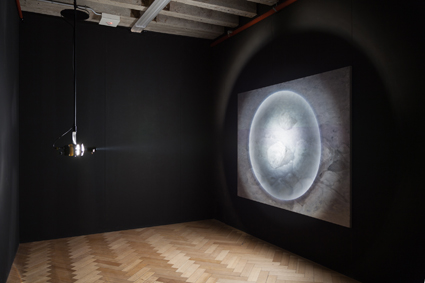Made wise by disorientation
Urszula Dawkins: Scott Miles, Nothing under the sun

Scott Miles, Nothing under the sun, courtesy the artist
Stepping into what seems to be a darkened corridor, I wait for my eyes to adjust…but they don’t. There’s just darkness; and in the distance, a small square of dim, glowing light. My hand touches the matt black paint on the wall to my left; the right wall, I think, runs straight ahead. So I feel my way with my hand, and a metre or so along I find a vertical slit; I look through. It reveals a room containing a large image in black and white, of luminous, snow-covered rocks or ice. I guess that if I follow this wall, I will find a break or a corner, will be able to turn left and left again, to access this room.
I keep going, very disoriented, but drawn forward by the touch of my hand on the wall, which sometimes changes texture as if there is a smooth steel edge of a panel, and then another panel. I’m not sure whether perhaps the wall is curving. I continue in this absolute black; surprised, fascinated, apprehensive. As I approach the end, the distant glow turns into a small light box on the wall, and then into a very small painting on reflective copper—an orange sun in a black landscape—and my hand finally reaches a large opening. A long, dim room extends back towards the entrance.
Before even beginning to ‘see’ Scott Miles’ Nothing under the sun, I’ve experienced a really strange sensory place, nearly lightless but for a vague, sun-like impression, far away. While negotiating the dark, I’ve been pursued by weird taps, pitches and clicks that remind me of bat or dolphin sonar; and pale, flange-ing drones like humming hard-drive fans. I’ve glimpsed, teasingly, light reflected off snow.
In the long ‘gallery’, when I reach it, I can see—just. On a video screen, what seems to be snow flurries towards the viewer, apparently caught in the camera’s own light. Further along, there’s a large, round painting—ice and rocks again—in subtle, monochrome bands, tinged faintly pink and greenish. For a moment, I think I’ve found the room behind the slit—I think I can see the slit. I feel along the wall for it, for assurance. But there is no aperture, and that other room remains hidden.
And then I realise the painting is not round at all; its rectangular shape becomes clear in the shadows beyond the circular beam of light that illuminates it. That’s how dark the room is.
Nothing under the sun draws on Scott Miles’ experiences in Greenland’s Upernavik artists’ retreat, during winter, when the sun did not broach the horizon for many weeks. It was so dark, he said, he took photos in order to see his surroundings (West Space artists’ talk, 28 August). The icy ground was treacherous, so getting around was difficult. Over time, he became acutely aware of sound and learned to move carefully so as not to slip or fall. In his paintings he wanted to experiment with “the removal of light,” and equally, “to bring the conditions of that experience into the exhibition environment”—in particular, to create a sense of duration.

Scott Miles, Nothing under the sun, courtesy the artist
The result is an unusual combination of painting—arguably the endangered polar bear of contemporary artforms—and light/sound installation. The gallery illumination is as faint as the starlight Miles became attuned to, consequently the paintings are eclipsed (but not obliterated) by the darkness and the AV-based (yet representational) form of the work as a whole. Their place here feels apt: as precise as photographs, they physically manifest time, contemplation and meticulous observation. Like the polar bear, they know where they are. Around them the soundscape, neither entirely abstract nor identifiable, shifts from speaker to hidden speaker. Combining found sounds and experiments with extreme frequencies, the audio is partly inspired by an Upernavik local’s recordings of radio waves emanating from the auroras: chirping, whistling siren-calls from Earth’s magnetosphere.
The Arctic, understandably, has become a regular muse for environmental laments, and a symbol of disintegration, loss and fragility in the work of many artists. Nothing under the sun is refreshing for not fetishising the melting icebergs and crumbling glaciers, nor asking us to contemplate the demise of the frozen north. Miles’ work lets the Arctic be just what it is: a place that whistles and rolls its hard-to-believe sounds around the ears; that challenges two-legged animals to see or stand up straight, at times; and that fascinates, disorients and unsettles in ways that will always resist the overlay of human meaning.
Scott Miles, Nothing under the sun; West Space, Melbourne, 1–30 Aug
You can read about Urszula Dawkins’ Arctic experience in The Arctic Circle international arts/science collaborative residency, Svalbard, Norway in RealTime 100.
RealTime issue #123 Oct-Nov 2014 pg. 54






